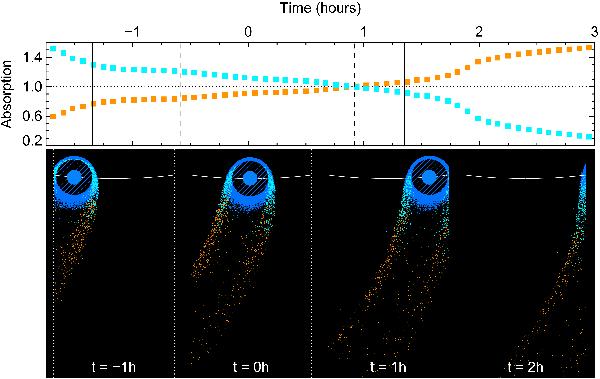Fig. 25

Top panel: absorption over the range −130 to −85 km s-1 (orange symbols) and −85 to −40 km s-1 (blue symbols), normalized by the absorption over the whole velocity interval, which corresponds to the interval of the absorption signature detected by Vidal-Madjar et al. (2003). The velocities are the projections on the star/Earth line of sight. Each point corresponds to a time step in a simulation of atmospheric escape from HD 209458b (escape rate Ṁ = 109 g s-1; ionizing flux Fion = 3 F⊙). Vertical solid lines show the beginning and end of ingress and egress of the transit, and vertical dashed lines show the beginning and end of STIS transit observations. Bottom panel: views of the gas in the orbital plane that moves with velocities in the intervals described above (orange and light blue), and below ±40 km s-1 (deep blue). The atmosphere below the exobase (striped disk) is uniformely filled with high-density neutral hydrogen gas. The hydrogen atoms are accelerated by radiation pressure and reach higher velocities farther away from the planet (blue disk). At different times during and after the transit, different areas of the cloud cross in front of the stellar disk (the field of view from the Earth is delimited by the dashed white lines). As a result, the relative absorption at low (high) velocities decreases (increases) with time.
Current usage metrics show cumulative count of Article Views (full-text article views including HTML views, PDF and ePub downloads, according to the available data) and Abstracts Views on Vision4Press platform.
Data correspond to usage on the plateform after 2015. The current usage metrics is available 48-96 hours after online publication and is updated daily on week days.
Initial download of the metrics may take a while.


